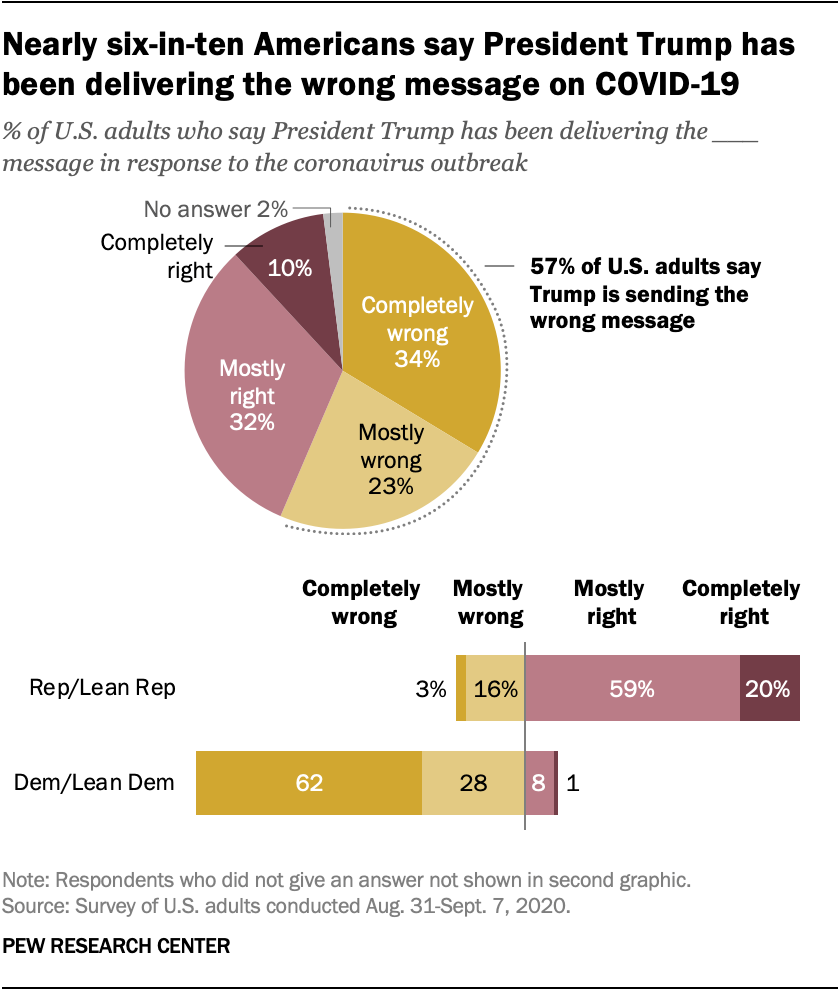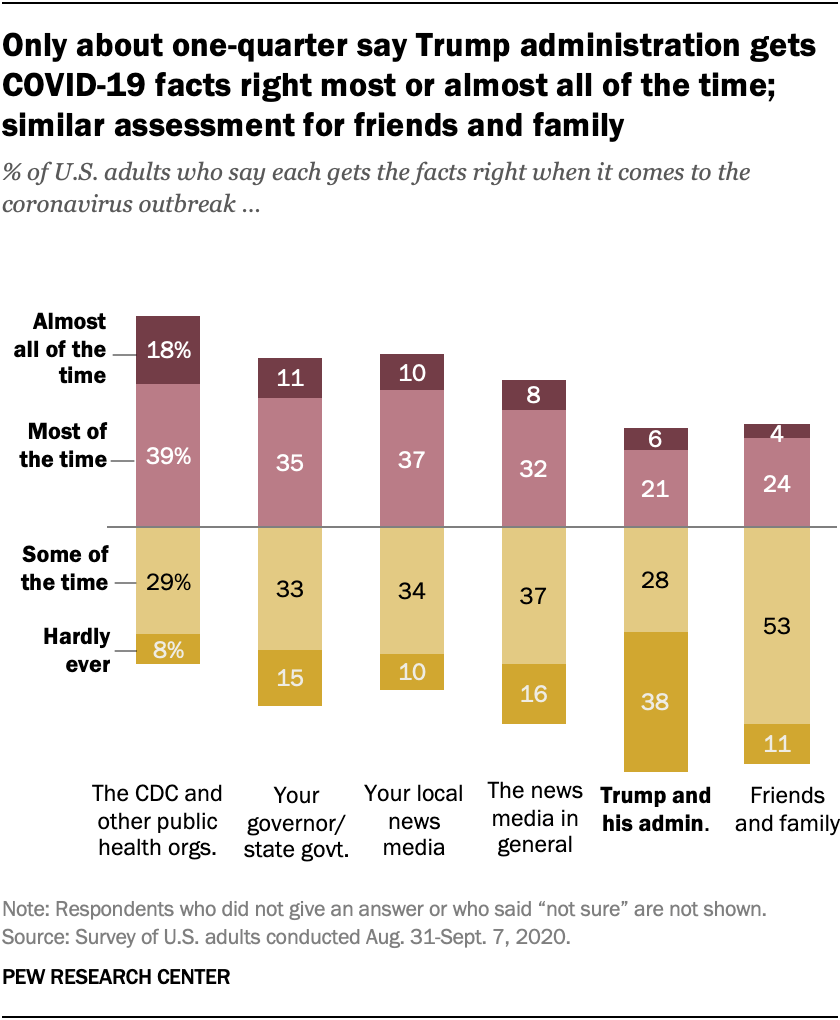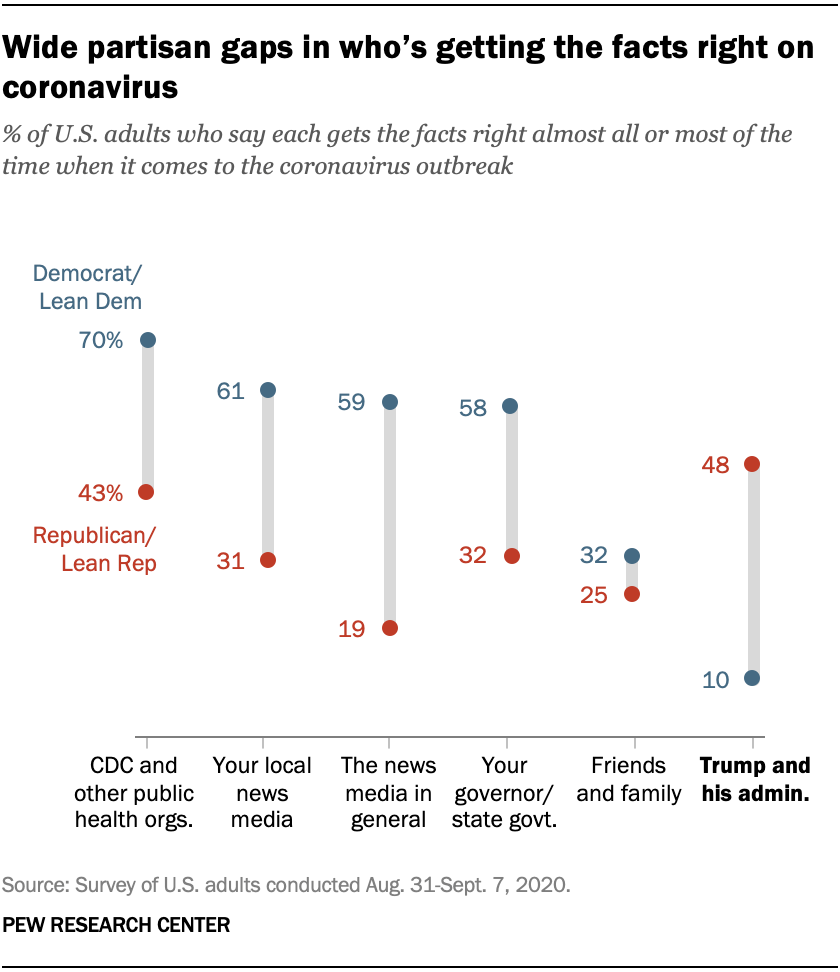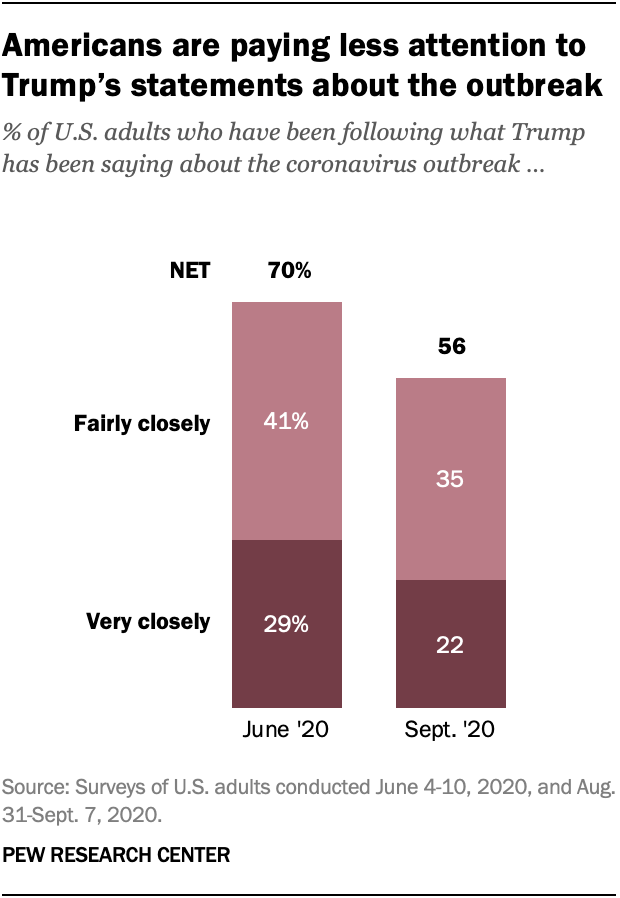
Excerpts from Bob Woodward’s new book in which President Donald Trump expresses deeper concern about the dangers of COVID-19 than he was publicly conveying at the time have thrust Trump’s statements and messaging on the pandemic back into the campaign spotlight.
The revelations come at a time when Americans are following Trump’s statements on that subject less closely than a few months ago, even though they are still paying close attention to the pandemic overall, according to a new survey, conducted before Woodward’s recordings were published, that is part of Pew Research Center’s American News Pathways project.
When it comes to Trump’s statements, nearly six-in-ten U.S. adults (57%) say the president has been delivering the wrong message about the coronavirus outbreak to the country, and two-thirds say Trump and his administration only sometimes or hardly ever get the facts right about the outbreak. The survey also finds large partisan gaps when it comes to the administration’s credibility and messaging about the pandemic.
Among the 57% of Americans who say Trump has been delivering the wrong message to the country, 23% say it is mostly wrong while 34% say it is completely wrong. That compares with 42% who say his message on coronavirus has been completely right (10%) or mostly right (32%).
To explore Americans’ views of President Trump’s messaging around the COVID-19 pandemic, we surveyed 9,220 U.S. adults from Aug. 31 to Sept. 7, 2020, as part of the American News Pathways project. Everyone who took part is a member of Pew Research Center’s American Trends Panel (ATP), an online survey panel that is recruited through national, random sampling of residential addresses. This way nearly all U.S. adults have a chance of selection. The survey is weighted to be representative of the U.S. adult population by gender, race, ethnicity, partisan affiliation, education and other categories. Read more about the ATP’s methodology. Here are the questions used for this report, along with responses, and its methodology.
There are gaping differences between Democrats and Republicans. Among Republicans and independents who lean Republican, only 19% characterize Trump’s message as mostly wrong (16%) or completely wrong (3%). In stark contrast, 90% of Democrats and independents who lean Democratic say that message is mostly wrong (28%) or completely wrong (62%).
The Aug. 31-Sept. 7 survey of 9,220 U.S. adults also asked Americans how often a number of different sources of coronavirus information get their facts about the outbreak right. About a quarter (27%) say Trump and his administration get the facts right almost all of the time (6%) or most of the time (21%) – numbers that are virtually unchanged since June.
That ranks the administration behind the Centers for Disease Control and Prevention and other public health organizations, which are characterized by 57% of Americans as getting their facts right almost all of the time or most of the time; local news media and a person’s governor and state government (both 46% right almost all or most of the time); and the news media in general (40%).
Friends, family and acquaintances get similarly low marks as the administration when it comes to getting their facts right about the outbreak. Only about a quarter of Americans (28%) say friends, family and acquaintances get their facts right almost all of the time or most of the time.
On this question as well, there is a major gap by party affiliation – though in neither case do a majority of Democrats or Republicans give the White House positive marks. About half of all Republicans (48%) say the Trump administration gets its facts about coronavirus right almost all of the time (10%) or most of the time (39%). That is roughly the same as the 45% who say some of the time (36%) and hardly ever (9%). Among Democrats, an overwhelming majority says the administration gets its facts right either some of the time or hardly ever (85%), with 19% saying they do so some of the time and about another two-thirds (65%) saying hardly ever.
One bipartisan finding in the new survey is that, by very similar percentages, both Democrats and Republicans are paying less attention to what Trump says about the outbreak than they were a few months earlier.
As of this month, 56% of all Americans say they are following Trump’s statements either very closely (22%) or fairly closely (35%). But that is down considerably from the 70% in June who were following Trump either very closely (29%) or fairly closely (41%).
The decrease is basically the same on both sides of the aisle. Republicans following Trump very or fairly closely dropped from 73% in June to 58% now. For Democrats, the percentage fell from 69% in June to 57% in September.
This decrease in attention to Trump’s statements about COVID-19 comes even as overall public interest in news about the outbreak remains high. In September, 82% of Americans say they are following news about the coronavirus very closely (35%) or fairly closely (46%). That is nearly as high as in June, when 86% said they were following it very closely (39%) or fairly closely (46%).
Note: Here are the questions used for this report, along with responses, and its methodology.



